Langley Research Center
The Langley Research Center (LaRC or NASA Langley) located in Hampton, Virginia, United States, is the oldest of NASA's field centers.[1] It directly borders Langley Air Force Base and the Back River on the Chesapeake Bay. LaRC has focused primarily on aeronautical research, but has also tested space hardware at the facility, such as the Apollo Lunar Module. In addition, a number of the earliest high-profile space missions were planned and designed on-site, and Langley was considered a potential site for the NASA's Manned Space Center prior to the eventual selection of Houston.[4]
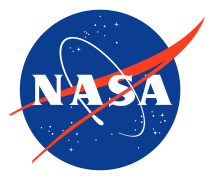 | |
.jpg) Aerial view of NASA Langley in 2011 | |
| Agency overview | |
|---|---|
| Formed | 1917 |
| Preceding agency |
|
| Jurisdiction | US Federal Government |
| Headquarters | Hampton, Virginia, United States |
| Employees | 1,821 (2017) |
| Agency executives |
|
| Parent agency | NASA |
| Website | www |
| Map | |
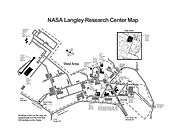 Map of NASA Langley Research Center | |
| Footnotes | |
| [1][2][3] | |
Established in 1917 by the National Advisory Committee for Aeronautics (NACA), the research center devotes two-thirds of its programs to aeronautics, and the rest to space. LaRC researchers use more than 40 wind tunnels to study and improve aircraft and spacecraft safety, performance, and efficiency. Between 1958 and 1963, when NASA (the successor agency to NACA) started Project Mercury, LaRC served as the main office of the Space Task Group.
In September 2019, after previously serving as associate director and deputy director, Clayton P. Turner was appointed director of NASA Langley.[3]
History
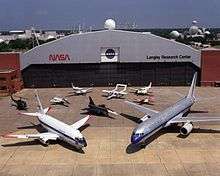
After US-German relations had deteriorated from neutral to hostile around 1916, the prospect of U.S. war entry became possible. On February 15, 1917, the newly established Aviation Week warned that the U.S. military aviation capability was less than what was operating in the European war.[5] President Woodrow Wilson sent Jerome Hunsaker to Europe to investigate, and Hunsaker's report prompted Wilson to command the creation of the nation's first aeronautics laboratory, which became NASA Langley.[6]
In 1917, less than three years after it was created, the NACA established Langley Memorial Aeronautical Laboratory on Langley Field. Both Langley Field and the Langley Laboratory are named for aviation pioneer Samuel Pierpont Langley.[7] The Aviation Section, U.S. Signal Corps had established a base there earlier that same year. The first research facilities were in place and aeronautical research was started by 1920. Initially the laboratory included four researchers and 11 technicians.[8]

Langley Field and NACA began parallel growth as air power proved its utility during World War I. The center was originally established to explore the field of aerodynamic research involving airframe and propulsion engine design and performance. In 1934 the world's largest wind tunnel was constructed at Langley Field with a 30-by-60-foot (9.1 m × 18.3 m) test section; it was large enough to test full-scale aircraft.[9][10] It remained the world's largest wind tunnel until the 1940s, when a 40-by-80-foot (12 m × 24 m) tunnel was built at NASA Ames Research Center in California.[11]
Early in 1945, the center expanded to include rocket research, leading to the establishment of a flight station at Wallops Island, Virginia. A further expansion of the research program permitted Langley Research Center to orbit payloads, starting with NASA's Explorer 9 balloon satellite in mid-February 1961. As rocket research grew, aeronautics research continued to expand and played an important part when subsonic flight was advanced and supersonic and hypersonic flight were introduced.
Langley Research Center can claim many historic firsts, some of which have proven to be revolutionary scientific breakthroughs. These accomplishments include the development of the concept of research aircraft leading to supersonic flight, the world's first transonic wind tunnels, training the first crews of astronauts, the Lunar Landing Facility providing the simulation of lunar gravity, and the Viking program for Mars exploration.[12] The center also developed standards for the grooving of aircraft runways based on a previous British design used at Washington National Airport.[13] Grooved runways reduce aquaplaning which permits better grip by aircraft tires in heavy rain. This grooving is now the international standard for all runways around the world.
Langley was also a contender for site NASA Mission Control, prior to the eventual selection of Houston, due to both Langley's prominence with NASA at the time, the large existing aerospace industry already present in the Hampton Roads region, and the proximity to Washington, DC. The selection of Houston actually took many higherups at Langley by surprise and caused some lingering controversy in the surrounding area over the loss and transfer of so many jobs to Houston. Though they had lost out on the Manned Space Center, Langley still played an important role in conducting research and training during the Apollo Program.[14]
Aeronautics
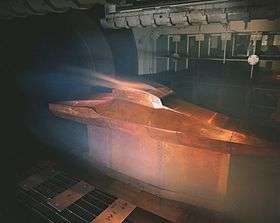
Langley Research Center performs critical research on aeronautics, including wake vortex behavior, fixed-wing aircraft, rotary wing aircraft, aviation safety, human factors and aerospace engineering. LaRC supported the design and testing of the hypersonic X-43, which achieved a world speed record of Mach 9.6 (11,760.4 km/h; 7,307.6 mph). LaRC assisted the NTSB in the investigation of the crash of American Airlines Flight 587.[15][16][15]
Work began in July 2011 to remove the 1940s era 16 feet (4.9 m) transonic wind tunnel. The facility supported development and propulsion integration research for many military aircraft including all fighters since 1960 (F-14, F-15, F-16, F-18 and the Joint Strike Fighter) but had been inactive since 2004.[17] Langley retained transonic wind tunnel testing capabilities facilities in the National Transonic Facility, a high pressure, cryogenically cooled 8.2 feet (2.5 m) closed loop wind tunnel.[18]
Fabrication research and development

Electron beam freeform fabrication (EBF³)
The EBF³ process produces structural metallic parts with immense strength. Additionally, the ability to build functionally graded, unitized parts directly from CAD data offers performance in most applications. Recently, LaRC has become home to this type of machining process, which is used by their new room-sized electron-emitting device, which uses a High Frequency 56 hp (42 kW), X-ray emitting electron gun (similar to Cathode Ray Tubes), which quickly melts either aluminum or titanium wire (positioned by dual independent wire feeders) into the desired 3-dimensional metallic parts with a material strength comparable to that of wrought products. The machine's deposition rate is 150 in3/h (680 cm3/ks) Metallic parts are also built directly from CAD without molds or tools, leaving the end product with absolutely no porosity.
Plastic fabrication
LaRC also houses a large collection of various inexpensive plastic reformation machines. These machines are critical in the freeform fabrication department for faster timing, better precision, and larger quantities of low-cost toy, model, and industrial plastic parts. The fabrication of plastic parts is not all that dissimilar to the EBF³ process, except the melting apparatus is a thin, grated heating element, but other than that they are quite similar, e.g. they are both run completely by CAD data and deal with various freeform fabrication of raw materials.
Astronautics
Moon
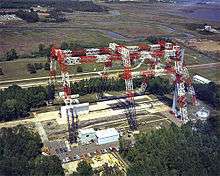
Since the start of Project Gemini, Langley was a center for training of rendezvous in space. In 1965, Langley opened the Lunar Landing Research Facility for simulations of Moon landings with a mock Apollo Lunar Module suspended from a gantry over a simulated lunar landscape. There was experimental work on some Lunar Landing Research Vehicles (LLRV).
Mars
Langley Research Center supported NASA's mission by designing a spacecraft for a Mars landing. (see the Mars Exploration Rover.)
Earth science
Langley Research Center conducts Earth science research to support NASA's mission.
Awards
LRC scientists and engineers have won the Collier Trophy 5 times. In 1929 for the development of low-drag cowling for radial air-cooled aircraft engines, 1946 to Lewis A. Rodert, Lawrence D. Bell and Chuck Yeager for the development of an efficient wing deicing system, 1947 to John Stack of the then Langley Memorial Aeronautical Laboratory for research to determine the physical laws affecting supersonic flight, also shared in this trophy for their work on supersonic flight, 1951 to John Stack for the development and use of the slotted-throat wind tunnel, 1954 Richard T. Whitcomb for the development of the Whitcomb area rule, according to the citation, a "powerful, simple, and useful method of reducing greatly the sharp increase in wing drag heretofore associated with transonic flight, and which constituted a major factor requiring great reserves of power to attain supersonic speeds."[19]
See also
- Aerospace engineering
- NASA field centers and other facilities
- TsAGI Russia's equivalent test center and research institute
References
- Bob Allen (December 17, 2015). "Dr. David E. Bowles, Director, NASA Langley Research Center". NASA Langley Research Center. Archived from the original on January 1, 2018. Retrieved January 1, 2018.
NASA Langley, founded in 1917, is the Nation's first civilian aeronautical research facility and NASA's oldest field center.
- "FY 2017 Agency Financial Report" (PDF). NASA. November 15, 2017. pp. 10, 24, 146. Archived from the original (PDF) on January 1, 2018. Retrieved January 1, 2018.
- Samuel McDonald (September 1, 2019). "Clayton P. Turner, Director, NASA Langley Research Center". NASA Langley Research Center. Archived from the original on February 6, 2020. Retrieved February 6, 2020.
Clayton Turner is the Director of NASA's Langley Research Center, Hampton, Virginia. Turner has served the agency for more than 29 years. He has held several roles at NASA Langley, including systems engineer, Chief Engineer, Engineering Director, Associate Center Director, and Deputy Center Director.
- Korsgaard, Sean (July 20, 2019). "Williamsburg recalls watching Apollo 11 and helping crew get there". Virginia Gazette, Daily Press. Tribune Media. Retrieved July 24, 2019.
- Aviation & Aeronautical Engineering, February 15, 1917
- Joe Anselmo (February 17, 2017). "Aviation Week's Warning and the Founding of NASA Langley". Aviation Week & Space Technology. Retrieved March 7, 2017.
- Tennant, Diane (September 5, 2011). "What's in a name? NASA Langley Research Center". The Virginian-Pilot. Retrieved September 5, 2011.
- "Journey in Aeronautical Research: a Career at NASA-Langley Research Center, ch. 3". NASA.
- "Faster, Safer Planes, Developed In Biggest Wind Tunnels" Popular Science, April 1934
- "Full-Size Planes Tested In Big Air Tunnel" Popular Mechanics, April 1935, pp. 520–521
- "40 X 80 and 80 X 120 Foot Wind Tunnels". Rotorcraft.arc.nasa.gov. Archived from the original on March 4, 2016. Retrieved February 14, 2016.
- "NASA Langley History and Description: Initial Activities". NASA LaRC Master Plan.
- McGuire, R.C. "REPORT ON GROOVED RUNWAY EXPERIENCE AT WASHINGTON NATIONAL AIRPORT". Internet Archive. Federal Aviation Administration. Retrieved February 5, 2017.
- Korsgaard, Sean (July 20, 2019). "Williamsburg recalls watching Apollo 11 and helping crew get there". Virginia Gazette, Daily Press. Tribune Media. Retrieved July 24, 2019.
- "NASA – Hypersonic X-43A Takes Flight". Nasa.gov. Retrieved February 14, 2016.
- "NASA Cultural Resources (CRGIS) – NasaCRgis". Gis.larc.nasa.gov. August 4, 2015. Retrieved February 14, 2016.
- "Tearing down NASA Langley's 16-foot transonic wind tunnel". Daily Press. July 8, 2011. Retrieved February 14, 2016.
- "National Transonic Facility". Archived from the original on October 17, 2011. Retrieved November 14, 2011.
- "Exploring NASA's Roots – The History of the Langley Research Center | NASA". Nasa.gov. December 31, 1992. Retrieved February 14, 2016.
External links
| Wikimedia Commons has media related to Langley Research Center. |
- Langley Research Center website
- Langley Archives Collection at Cultural Resources Geographical Information Systems (CRGIS), NASA
- James R. Hansen: Spaceflight Revolution: NASA Langley Research Center from Sputnik to Apollo (NASA SP-4308, 1995)
- Crafting Flight: Aircraft Pioneers and the Contributions of the Men and Women of NASA Langley Research Center (NASA SP-2003-4316)
- Engineer in Charge: A History of the Langley Aeronautical Laboratory,1917–1958 (NASA SP-4305, 1987)
- Journey in Aeronautical Research: a Career at NASA-Langley Research Center, Monographs in Aerospace History No. 12
- Historic American Engineering Record documentation (all located in Hampton, Independent City, VA):
- HAER No. VA-118-A, "NASA Langley Research Center, Full-Scale Wind Tunnel, 224 Hunting Avenue (Building No. 643)", 27 photos, 2 measured drawings, 36 data pages, 4 photo caption pages
- HAER No. VA-118-B, "NASA Langley Research Center, 8-Foot High Speed Wind Tunnel, 641 Thornell Avenue (Building No. 641)", 29 photos, 1 measured drawing, 44 data pages, 4 photo caption pages
- HAER No. VA-118-C, "NASA Langley Research Center, Seaplane Towing Channel, 108 Andrews Street (Building No. 720)", 25 photos, 2 measured drawings, 25 data pages, 3 photo caption pages
- HAER No. VA-118-D, "NASA Langley Research Center, 8-Foot Transonic Pressure Tunnel, 640 Thornell Avenue (Building No. 640)", 12 photos, 16 data pages, 2 photo caption pages
- HAER No. VA-118-E, "NASA Langley Research Center, 16-Foot Transonic Wind Tunnel, 11 West Taylor Street (Building No. 1146)", 15 photos, 17 data pages, 2 photo caption pages
- HAER No. VA-118-F, "NASA Langley Research Center, 7- x 10-Foot High Speed Wind Tunnel, 11 West Taylor Street (Building No. 1212B)", 9 photos, 9 data pages, 1 photo caption page
- HAER No. VA-118-H, "NASA Langley Research Center, Two-Dimensional Low Turbulence Pressure Tunnel, 582A Thornell Avenue (Building No. 582A)", 19 photos, 24 data pages, 2 photo caption pages